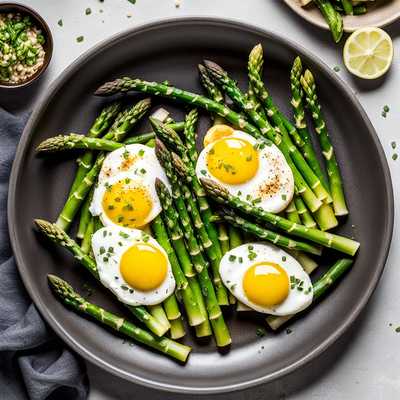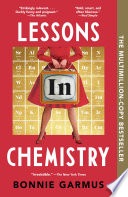Pair the fresh and light flavors of Asparagus and Eggs with the engaging contemporary novel "Lessons in Chemistry" by Bonnie Garmus and a refreshing Hugo Spritz cocktail. This trio combines the appreciation of simplicity and elegance across culinary, literary, and beverage experiences. Asparagus and Eggs offer a palette of earthy greens and luxurious eggs, complementing the playful yet profound narrative of the book, while the Hugo Spritz adds a fragrant and fizzy twist to the experience.

Ingredients
- 1 bunch of asparagus, trimmed
- 2 tablespoons olive oil, divided
- 4 large eggs
- Salt and pepper, to taste
- 1 tablespoon butter
- 1 clove garlic, minced
- 1/4 teaspoon red pepper flakes (optional)
- 1/4 cup grated Parmesan cheese (optional)
- Fresh herbs (such as chives, parsley, or dill), chopped (for garnish)
Instructions
- Prepare the asparagus: Preheat your oven to 400°F (200°C). Place the trimmed asparagus spears on a baking sheet. Drizzle with 1 tablespoon of olive oil and season with salt and pepper. Toss to coat the asparagus evenly.
- Roast the asparagus: Roast the asparagus in the preheated oven for 10-12 minutes, or until tender and slightly caramelized.
- Cook the eggs: While the asparagus is roasting, heat the remaining 1 tablespoon of olive oil and 1 tablespoon of butter in a large skillet over medium heat. Add the minced garlic and red pepper flakes (if using) and sauté for about 1 minute until fragrant.
- Prepare the eggs: Cook the eggs to your liking (poached, fried, or scrambled). For poached eggs, bring a pot of water to a gentle simmer, add a splash of vinegar, and poach the eggs for 3-4 minutes until the whites are set but the yolks are still runny. For fried eggs, crack the eggs into the skillet with the garlic and cook until the whites are set and the edges are crispy. For scrambled eggs, whisk the eggs in a bowl, pour them into the skillet, and cook gently, stirring constantly until softly set.
- Serve: Arrange the roasted asparagus on a serving platter. Top with the cooked eggs. Sprinkle with grated Parmesan cheese (if using) and garnish with chopped fresh herbs.
Lessons in Chemistry

In the 1960s, life as a female scientist is not exactly accommodating, as Elizabeth Zott discovers when she joins a research program dominated by men. Her passion for chemistry leads her to unusual opportunities, including becoming an unconventional cooking show host. Balancing wit and wisdom, "Lessons in Chemistry" navigates themes of empowerment, scientific curiosity, and challenging societal norms.
#1 GLOBAL BESTSELLER WITH MORE THAN 8 MILLION COPIES SOLD • Meet Elizabeth Zott: “a gifted research chemist, absurdly self-assured and immune to social convention” (The Washington Post) in 1960s California whose career takes a detour when she becomes the unlikely star of a beloved TV cooking show. • STREAM ON APPLE TV+ This novel is “irresistible, satisfying and full of fuel” (The New York Times Book Review) and “witty, sometimes hilarious…the Catch-22 of early feminism” (Stephen King, via Twitter). A BEST BOOK OF THE YEAR: The New York Times, Washington Post, NPR, Oprah Daily, Entertainment Weekly, Newsweek Chemist Elizabeth Zott is not your average woman. In fact, Elizabeth Zott would be the first to point out that there is no such thing as an average woman. But it’s the early 1960s and her all-male team at Hastings Research Institute takes a very unscientific view of equality. Except for one: Calvin Evans; the lonely, brilliant, Nobel–prize nominated grudge-holder who falls in love with—of all things—her mind. True chemistry results. But like science, life is unpredictable. Which is why a few years later Elizabeth Zott finds herself not only a single mother, but the reluctant star of America’s most beloved cooking show Supper at Six. Elizabeth’s unusual approach to cooking (“combine one tablespoon acetic acid with a pinch of sodium chloride”) proves revolutionary. But as her following grows, not everyone is happy. Because as it turns out, Elizabeth Zott isn’t just teaching women to cook. She’s daring them to change the status quo. Laugh-out-loud funny, shrewdly observant, and studded with a dazzling cast of supporting characters, Lessons in Chemistry is as original and vibrant as its protagonist.
Discussion Questions
- How does Elizabeth Zott navigate the challenges of being a female scientist in a male-dominated field?
- Discuss the role of chemistry and science as a metaphor throughout the story.
- In what ways does the novel address gender stereotypes and progressive ideals?
- What are the key turning points for Elizabeth's character within the novel?
- How does the cooking show serve as a means of empowerment for Elizabeth?
- Examine the author's use of humor and how it complements the serious themes in the book.
- Discuss the relationships Elizabeth forms throughout the book—isolation versus community.
- How does the novel's historical setting influence the story's themes?
- What do you think are the "lessons" in "Lessons in Chemistry"?
- How does Elizabeth's story resonate with current conversations about women in STEM fields?
Authors:
Bonnie Garmus
ISBN: 038554734X
Publisher: Random House
Published Date: 2025-04-01
ISBN: 038554734X
Publisher: Random House
Published Date: 2025-04-01
Hugo Spritz

The Hugo Spritz is a light and refreshing cocktail that combines elderflower and mint with the effervescence of Prosecco. It's an aromatic and fizzy drink that pairs beautifully with spring and summer dishes, enhancing the flavors of asparagus with its floral and slightly sweet profile.
Ingredients
- 1 part elderflower cordial (or liqueur)
- 3 parts Prosecco
- 1 splash of soda water
- Fresh mint leaves
- A slice of lime
- Ice cubes
Instructions
- Fill a large wine glass with ice cubes.
- Add the elderflower cordial.
- Top with Prosecco and a splash of soda water.
- Gently stir to combine.
- Garnish with fresh mint leaves and a slice of lime.